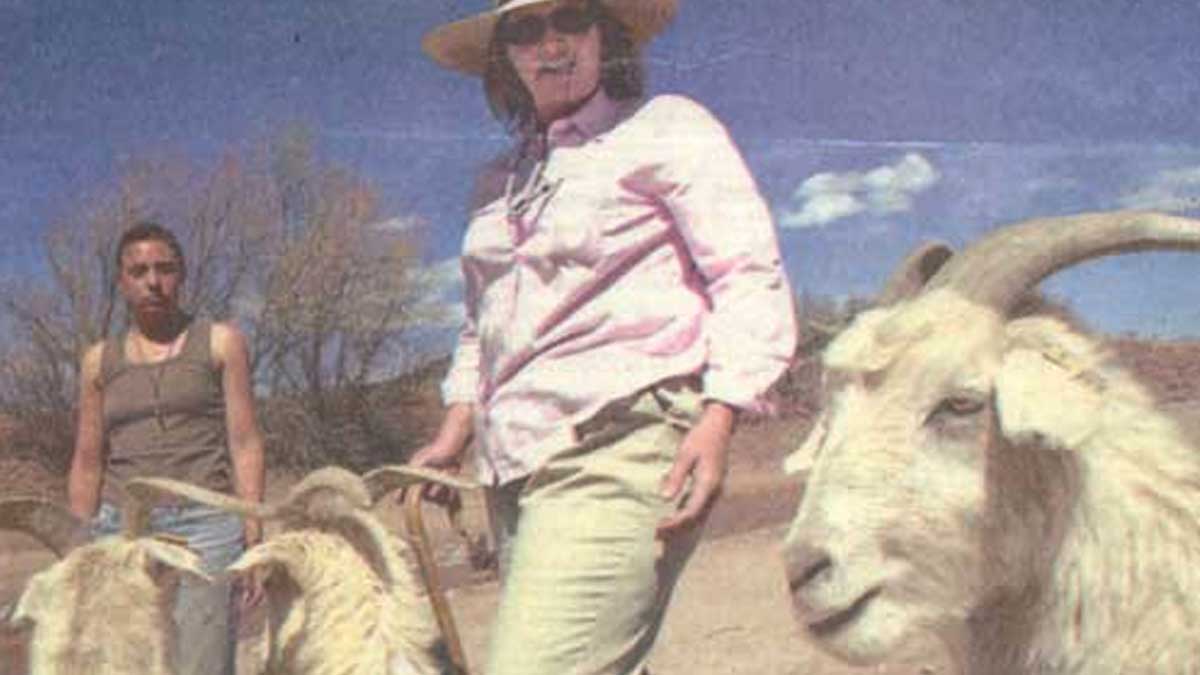
by Jennifer McKee | Albuquerque Journal | April 19, 2002
Only two things will get rid of salt cedar, Lani Lamming said, her mirrored sunglasses reflecting a dry Galisteo Creek. A nuclear bomb or the pitter patter of tiny hooves. Lamming opts for the latter.
She’s here, on Leslie Barclay’s place near Cerrillos, with 1,000 cashmere wethers. (That’s goat-speak for neutered males.) The goats, yellow-eyed and three feet tall, are doing a number on the snags of salt cedar and Russian olive that have virtually taken over the creek bottom.
Their process is simple, Lamming said. The goats eat the new shoots, scrape off some bark, all the while breaking apart the clumped soil and depositing what Lamming politely refers to as “100 percent organic fertilizer” behind them.
The result is a stressed out salt cedar. Stress them enough, and the invasive trees notorious along New Mexico’s waterways for sucking up hundreds gallons of water a day and giving back only salt, will die.
What’s more, Lamming said, the goats also eat down the dead, cured grasses from last year, letting sunshine hit the new shoots of this spring.
This is Lamming’s first trip to New Mexico and already she knows she and the goats will be back. Lamming owns Ewe4ic Ecological Services out of Alpine, Wyo. Her goats are working goats. They eat noxious weeds, poisonous plants, invasive shrubs and trees. They’ll even eat trash.
“Goats are browsers,” Lamming said. “They don’t like grass.” Their culinary delights are the banes of the Western range: Canada thistle, Russian and spotted knapweed, leafy spurge, white top; They eat Choya cactus, sage brush, juniper.
They don’t just eat the weeds, Lamming said, they’ll actually kill them.
And that is why Lamming is so busy, she doesn’t even have a home anymore. Effective goat grazing can kill noxious weeds without the use of sprayed chemicals.

In Lamming’s experience, the goats are as effective as poisonous chemicals, and in some cases, much more successful. They can go where spraying isn’t allowed: beside waterways, in environmentally sensitive areas like national parks, and the town of Taos, which hired the goats after the town banned the spraying of chemicals to control noxious weeds. And they eat things like salt cedar for which there is no easy chemical cure.
“We’re on the road 364 days a year,” Lamming said. “I have more business than I can handle.” Her wethers are here, while the nannies -that’s a female goat with a kid -are in Cheyenne, Wyo.
She’s in New Mexico at Bar clay’s invitation. Barclay owns Earth Works Institute, a group that tries to find natural ways of fixing unhealthy ecosystems. Lamming and the goats will be here, about 20 miles from Santa Fe, for a couple more weeks. Then, they head to a ranch near Cuba, where she’s putting on a weed-eating demonstration program for the Bureau of Land Management.
From there, the goats head north, to Taos, where they’ll be controlling noxious weeds all over town, including along some highways, and munching on some aggressive sagebrush on a nearby ranch.
Booming business
Five years ago, Lamming was a busted rancher who had never even seen a goat. She ranched in Nebraska, Wyoming and Colorado.
“But I couldn’t make a living, so I went back to school,” Lamming said. She got a degree in weed science, where she read about goats but never actually saw one. Five years ago, fresh from college, she decided to give goats a try.
“My two sons took all their college savings and I took out a loan against my pickup truck to get the first 100 goats,” Lamming said.
At first, she had to price her services below the standard chemicals to get business. But word spread. Most people who tried the goats asked for them the next year.
Today, she has more than 2,100 goats, which she typically grazes from south to north, following the budding weeds. They work year round, as wintertime is actually a great time to kill noxious weeds, when they’re already stressed, Lamming said.
They graze in places you wouldn’t expect goats, like downtown Cheyenne and downtown Colorado Springs, where, Lamming said, the goats were such a hit, people scheduled their work breaks so they could watch Lamming’s border collies round the goats up every day at 4 p.m.
As a former rancher, Lamming is definitely pro-grazing and said cows could be as healthful on the range as goats, provided they are managed right and have a healthy range to begin with.
“It’s a great job,” she said. “People love to come watch us.”
Lamming works with a couple of goatherds, three border collies and a donkey, which instinctively keeps predators like stray dogs and coyotes away from the goats.
“It kicks them to death,” Lamming said.
